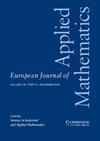聚电解质凝胶中电中性的分解
IF 1.1
4区 数学
Q1 MATHEMATICS, APPLIED
引用次数: 0
摘要
聚电解质凝胶的数学模型通常通过假设凝胶是电中性的来简化。这一假设背后的基本原理是,与凝胶的尺寸相比,凝胶自由表面处的双电层(EDL)的厚度较小。因此,取薄EDL极限,其中EDL的厚度设置为零。尽管薄EDL极限被广泛使用,但EDL中的解很少被计算出来,并且显示出与电中性体的解相匹配。本文的目的是研究EDL的结构,并建立瘦EDL极限的有效性。凝胶的模型考虑了相分离,这产生了厚度由库恩长度描述的扩散界面。我们证明,通常,当Debye长度远小于Kuhn长度时,EDL中的解只能渐近匹配于电中性体的解。如果德拜长度类似或大于库恩长度,则可以在EDL中开始相分离。这种相分离扩散到凝胶的主体中,并产生具有不同溶胀度的带电层。因此,薄EDL极限和电中性假设通常仅适用于德拜长度远小于库恩长度的情况。本文章由计算机程序翻译,如有差异,请以英文原文为准。
Breakdown of electroneutrality in polyelectrolyte gels
Mathematical models of polyelectrolyte gels are often simplified by assuming the gel is electrically neutral. The rationale behind this assumption is that the thickness of the electric double layer (EDL) at the free surface of the gel is small compared to the size of the gel. Hence, the thin-EDL limit is taken, in which the thickness of the EDL is set to zero. Despite the widespread use of the thin-EDL limit, the solutions in the EDL are rarely computed and shown to match to the solutions for the electrically neutral bulk. The aims of this paper are to study the structure of the EDL and establish the validity of the thin-EDL limit. The model for the gel accounts for phase separation, which gives rise to diffuse interfaces with a thickness described by the Kuhn length. We show that the solutions in the EDL can only be asymptotically matched to the solutions for an electrically neutral bulk, in general, when the Debye length is much smaller than the Kuhn length. If the Debye length is similar to or larger than the Kuhn length, then phase separation can be initiated in the EDL. This phase separation spreads into the bulk of the gel and gives rise to electrically charged layers with different degrees of swelling. Thus, the thin-EDL limit and the assumption of electroneutrality only generally apply when the Debye length is much smaller than the Kuhn length.
求助全文
通过发布文献求助,成功后即可免费获取论文全文。
去求助
来源期刊
CiteScore
4.70
自引率
0.00%
发文量
31
审稿时长
>12 weeks
期刊介绍:
Since 2008 EJAM surveys have been expanded to cover Applied and Industrial Mathematics. Coverage of the journal has been strengthened in probabilistic applications, while still focusing on those areas of applied mathematics inspired by real-world applications, and at the same time fostering the development of theoretical methods with a broad range of applicability. Survey papers contain reviews of emerging areas of mathematics, either in core areas or with relevance to users in industry and other disciplines. Research papers may be in any area of applied mathematics, with special emphasis on new mathematical ideas, relevant to modelling and analysis in modern science and technology, and the development of interesting mathematical methods of wide applicability.

 求助内容:
求助内容: 应助结果提醒方式:
应助结果提醒方式:


